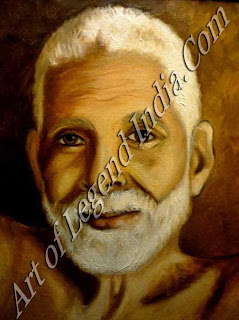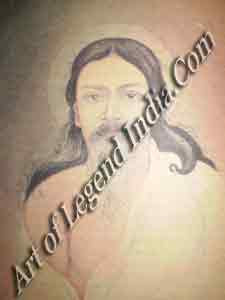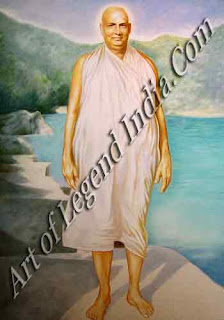 The last virtue that of self-control,
implies control of the five senses, the mind and the spirit. The importance of
discipline at the stage of a Brahmachari, during studentship, first initiates
the young into the control of the body and the mind and, in the later stages, as
a Grihastha and a Vanaprastha, to the control of the spirit also. Self-control
does not mean denying oneself. It means moderation in all things and avoidance
of indulgence. Even loose talk and harmful gossip are to be avoided, as are
over-eating and excessive drinking. Keeping one's body, mind and spirit under
control is one of the virtues enjoined on the Hindu at every stage of his life.
The last virtue that of self-control,
implies control of the five senses, the mind and the spirit. The importance of
discipline at the stage of a Brahmachari, during studentship, first initiates
the young into the control of the body and the mind and, in the later stages, as
a Grihastha and a Vanaprastha, to the control of the spirit also. Self-control
does not mean denying oneself. It means moderation in all things and avoidance
of indulgence. Even loose talk and harmful gossip are to be avoided, as are
over-eating and excessive drinking. Keeping one's body, mind and spirit under
control is one of the virtues enjoined on the Hindu at every stage of his life.
A common question asked is
whether Hinduism believes in the sins of Man and the punishment of God being
meted out to those committing these sins.
Hindus consider only
self-centred desire as a sin which leads to all the evils of mankind. However
we believe that it is not God who punishes us but our actions or Karma, as
explained earlier.
There are, however, six main
obstacles or vices which detract Man from performing his dharma. They are kama
(lust), krodha (unjust and vicious anger), lobha (greed and avarice), moha
(infatuation arising out of ignorance and delusion), mada (vanity resulting
from egoism) and matsarya (envy and jealousy).
To overcome them one should
practise some of the essential virtues which are taught to us in our various
epics. They are satyam (truth), ahimsa (non-violence), vairagya (detachment
from desires), purity of thought, word and deed and self control.
Saiyam does not only mean
merely speaking the truth. It means the permeation of Truth in our thoughts,
words and deeds and in our relationships with fellow human beings. Hinduism is
itself based on Truth and the pursuit of Truth. Truth is beautiful and untruth
ugly. The former leads to justice and righteousness in the world and to
scientific progress. It blazes new trails in the spiritual progress of Man.
Truth must not be confused with
morality. Truth is unchangeable. Concepts of morality change from time to time.
Much earlier it was explained that Hinduism alone of all religions accepts that
the laws of Man are changeable in each age. The Dharma of ancient India
enjoined that the brother-in-law of childless widow should marry the widow so
that she could bear children. Today this is no longer the practice. Punishments
of thieves by cutting off their hands was a common practice in ancient times,
but is no longer permitted. A man's dharma in ancient India followed his caste
or sect. Today one born a Brahmin owns a leather factory, one born a Kshatriya
takes to farming, one born a butcher becomes a Sanskrit scholar. The castes no
longer follow their occupational divisions. Yet society and politicians misuse
the defunct caste system for their own ends, the upper castes in order to
maintain an artificial social status for themselves, and the lower castes, for
getting special privileges for themselves.
Dharma or the laws of society
therefore change from age to age and should not be confused with Truth which is
unchangeable, transcending Time and Space. All the other virtues are only
different aspects of Truth which is all-encompassing. Even the slightest
deviation from Truth is considered Untruth and is unacceptable.
The belief `Ahimsa paramo
dharmah', or that Ahimsa or non-violence is the greatest of laws, is Hinduism's
great contribution to mankind. Mahatma Gandhi made this the cornerstone of the
Indian Independence movement, and oppressed people all over the world have
adopted it or drawn hope from it.
Ahimsa is often confused with
non-killing alone. A businessman may destroy his competitor by unfair means but
be a vegetarian in his food habits. He thinks he is practising Ahimsa but he is
not.
Vegetarianism is one of the
goals of Ahimsa in its ultimate form, but it also means not hurting anyone or
any being in thought, word or deed and not killing or causing pain to man or
animal. On the positive side, Ahimsa implies kindness to all people and one's
neighbours, care of animals and birds, indeed, of all life. It teaches
hospitality of the highest order to be extended to friends and enemies.
The reverence given to the cow,
based on Ahimsa or not killing one who provides a largely vegetarian nation
with milk products (much as a mother provides food for her young), is a part of
our reverence for Ahimsa.
The reverence for plants and
trees was ingrained in the people by asking them to protect the vana-devata,
the heavenly beings which reside inside trees. Thus, by preventing the cutting
down of trees, Hindus were the first to give spiritual emphasis to ecology and
the environment, considered modern-day subjects. Ahimsa is not a result of
cowardice but of strength. It is only the very strong in spirit who can choose
this path as, in today's world, with its napalm and neutron bombs, it is easy
indeed to practise violence and very hard to desist from it and to practise
Ahimsa.
The third important virtue,
detachment, is not a virtue enjoined on the young. It is only at the stage of a
Grihastha or householder that one should slowly start performing acts without
attachment to the results. When he becomes a Vanaprastha, a man should detach
himself from attachments to the body and soul and work for the good of all.
Detachment does not mean not loving one's near and dear ones. It means
extending love to all equally and not working only for or loving only the ones to
whom we are attached by family or emotional bonds. The Upanishads so rightly
say, Vasudhaiva Kinumbakam' (the whole world is my family).
Purity is often misunderstood
in India to be bodily purity alone. Rules of bathing, of eating and drinking,
all emphasise the importance of purity, as personal cleanliness is considered a
step towards godliness. But purity of the mind and spirit are equally
important, as is civic cleanliness, and often forgotten in our obsession with
physical purity.
 The last virtue that of self-control,
implies control of the five senses, the mind and the spirit. The importance of
discipline at the stage of a Brahmachari, during studentship, first initiates
the young into the control of the body and the mind and, in the later stages, as
a Grihastha and a Vanaprastha, to the control of the spirit also. Self-control
does not mean denying oneself. It means moderation in all things and avoidance
of indulgence. Even loose talk and harmful gossip are to be avoided, as are
over-eating and excessive drinking. Keeping one's body, mind and spirit under
control is one of the virtues enjoined on the Hindu at every stage of his life.
The last virtue that of self-control,
implies control of the five senses, the mind and the spirit. The importance of
discipline at the stage of a Brahmachari, during studentship, first initiates
the young into the control of the body and the mind and, in the later stages, as
a Grihastha and a Vanaprastha, to the control of the spirit also. Self-control
does not mean denying oneself. It means moderation in all things and avoidance
of indulgence. Even loose talk and harmful gossip are to be avoided, as are
over-eating and excessive drinking. Keeping one's body, mind and spirit under
control is one of the virtues enjoined on the Hindu at every stage of his life.
We have gone through the main
tenets of Hinduism, the concepts of Samsara, Karma and Dharma and the aim of
the individual soul to be liberated from the cycle of births and deaths so as
to reach the Brahman or the Absolute.
Writer
– Shakunthala Jagannathan
Subscribe to:
Post Comments (Atom)













0 Response to "Vices and Virtues of Soul "
Post a Comment